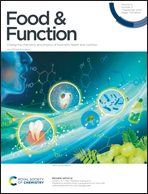Structure relationship of non-covalent interactions between lotus seedpod oligomeric procyanidins and glycated casein hydrolysate during digestion†
Abstract
Procyanidin-amino acid interactions during transmembrane transport cause changes in the structural and physical properties of peptides, which limits further absorption of oligopeptide-advanced glycation end products (AGEs). In this study, glycated casein hydrolysates (GCSHs) were employed to investigate the structure and interaction mechanism of GCSH with lotus seedpod oligomeric procyanidin (LSOPC) complexes in an intestinal environment. LSOPC can interact with GCSH under certain conditions to form hydrogen bonds and hydrophobic interactions to form GCSH–LSOPC complexes. Results showed that procyanidin further leads to the transformation of a GCSH secondary structure and the increase of surface hydrophobicity (H0). The strongest non-covalent interaction between GCSH and (−)-epigallocatechin gallate (EGCG) was due to the polyhydroxy structure of EGCG. Binding site analysis showed that EGCG binds to the internal cavity of P1 to maintain the relative stability of the binding conformation. The antioxidant capacity of GCSH was remarkably elevated by GCSH–LSOPC. This study will provide a new reference for the accurate control of oligopeptide-AGEs absorption by LSOPC in vivo.



 Please wait while we load your content...
Please wait while we load your content...